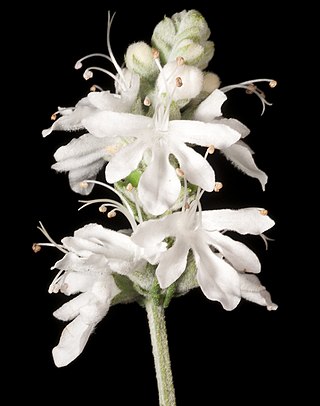
Teucrium is a cosmopolitan genus of flowering plants in the family Lamiaceae, commonly known as germanders. Plants in this genus are perennial herbs or shrubs, with branches that are more or less square in cross-section, leaves arranged in opposite pairs, and flowers arranged in thyrses, the corolla with mostly white to cream-coloured, lobed petals.

Theriac or theriaca is a medical concoction originally labelled by the Greeks in the 1st century AD and widely adopted in the ancient world as far away as Persia, China and India via the trading links of the Silk Route. It was an alexipharmic, or antidote for a variety of poisons and diseases. It was also considered a panacea, a term for which it could be used interchangeably: in the 16th century Adam Lonicer wrote that garlic was the rustic's theriac or Heal-All.
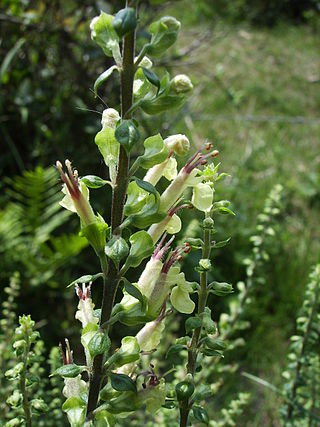
Teucrium scorodonia, common name the woodland germander or wood sage, is a species of flowering plant in the genus Teucrium of the family Lamiaceae. It is native to Western Europe and Tunisia, but cultivated in many places as an ornamental plant in gardens, and naturalized in several regions.

Teucrium marum, commonly known as cat thyme or kitty crack, is a species of germander. Its small, oval leaves give it a thyme-like appearance, but the musty scent is quite unlike the delicate aroma of thyme. Cat thyme is a mounding, tender perennial with grey-green leaves tipped by fragrant pink flowers in summer.

Teucrium chamaedrys, the wall germander, is a species of plant native to the Mediterranean regions of Europe and North Africa, and the Middle East as far as Iran. It was historically used as a medicinal herb for the treatment of gout and sometimes as a component of Venice treacle. It’s also used as an ornamental.
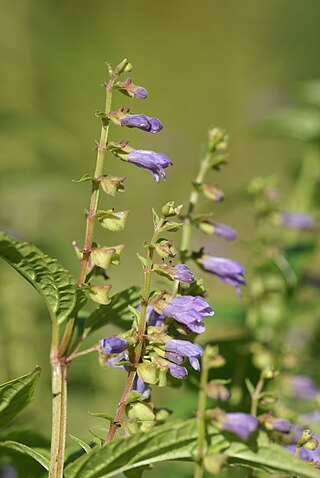
Scutellaria lateriflora, is a hardy perennial herb of the mint family, Lamiaceae, native to North America.

Teucrium fruticans is a species of flowering plant in the mint family Lamiaceae, native to the western and central Mediterranean. Growing to 1 m (3 ft) tall by 4 m (13 ft) wide, it is a spreading evergreen shrub with arching velvety white shoots, glossy aromatic leaves and pale blue flowers in summer.

Salvia chamaedryoides, or germander sage, is an evergreen perennial native to the high desert of the Sierra Madre Oriental range in Mexico. Its name comes from sharing the running rootstock typical of Teucrium chamaedrys. Spreading freely, it reaches a height of 60 cm when in bloom, with small grey evergreen foliage. The flowers are blue, appearing sporadically throughout the growing season, with peaks of bloom in early summer and autumn. It has been grown in European horticulture since the early 19th century, but was only introduced to the U.S. in the 1980s.
Teucrium glandulosum is a species of flowering plant in the mint family known by the common names sticky germander and desert germander. It is native to the Sonoran Desert of Arizona, Baja California, Baja California Sur, and San Bernardino County in California. It grows in rocky desert habitat such as canyons. The plant produces three-lobed leaves on its branching stem. The flowers have purple-streaked white corollas up to 2 centimeters long each with a large lower lobe and smaller lateral lobes. The inside of the flower is very hairy.
Capperia celeusi is a moth of the family Pterophoridae. It is known from most of Europe, Ukraine, Russia, Turkey, Lebanon, Turkmenistan and the United Arab Emirates.
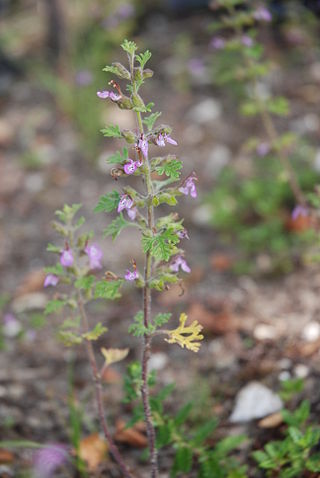
Teucrium botrys, the cutleaf germander or cut-leaved germander is a low to short downy annual, sometimes biennial, plant. It was noted by Carl Linnaeus in 1753 and is classified as part of the genus Teucrium in the family Lamiaceae. It has oval, but deeply cut leaves, which appear almost pinnate in form. Its flowers are two-lipped but with the upper lip diminutive. They are pink to purple and form from the stem at the base of the leaves, in whorls. It is in flower in the northern hemisphere from June to October. It prefers limy soils and bare stony ground. It is native to Western Europe, especially France and Germany. It has been introduced into north-eastern North America.

Teucrium corymbosum, commonly known as forest germander, is a species of flowering plant in the family Lamiaceae and is native to Australia and New Guinea. It is a perennial herb or subshrub densely covered with glands and with narrow egg-shaped leaves usually with toothed edges, and groups of mostly up to ten white flowers.

Teucrium canadense, commonly known as Canada germander, American germander, or wood sage, is a perennial herb in the family Lamiaceae. It is native to North America where it is found across the contiguous states of the United States and in much of Canada.
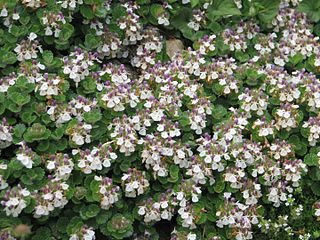
Teucrium pyrenaicum, the Pyrenean germander, is a species of germander native to the Pyrenees. It has gained the Royal Horticultural Society's Award of Garden Merit.
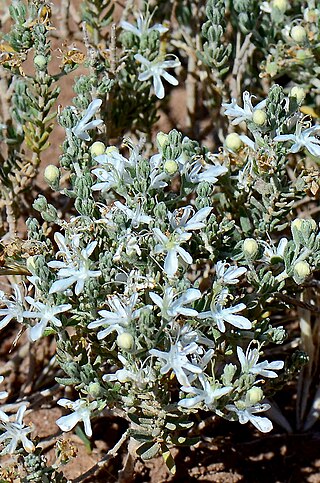
Teucrium albicaule, commonly known as scurfy germander, is a species of flowering plant in the family Lamiaceae, and is endemic to inland areas of Australia. It is a hoary, perennial herb that spreads by root suckers, forming dense stands. The leaves are trifoliate and the white flowers are arranged singly in leaf axils.

Teucrium argutum, commonly known as native germander, is a species of flowering plant in the family Lamiaceae, and is endemic to eastern Australia. It is a perennial herb often suckering, with hairy, broadly egg-shaped leaves with toothed or wavy edges, and pink-purple flowers.
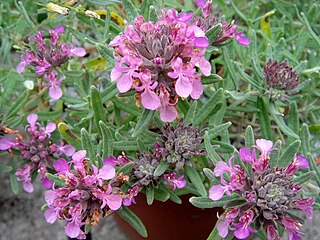
Teucrium ackermannii, the silver germander, is a flowering plant in the family Teucrioideae. It is of unknown origin and naming.

Teucrium montanum, the mountain germander, is a germander native to southern Europe, from Spain eastward to Turkey. It forms shrubs about a foot high, with small leaves no more than an inch across, and petals blooming yellowish white. On south-facing mountain slopes, it can be found as far up as 2400 meters in the Alps.

Teucrium flavum is a species of shrub in the family Lamiaceae. They have a self-supporting growth form and simple, broad leaves. Individuals can grow to 0.39 m.

















